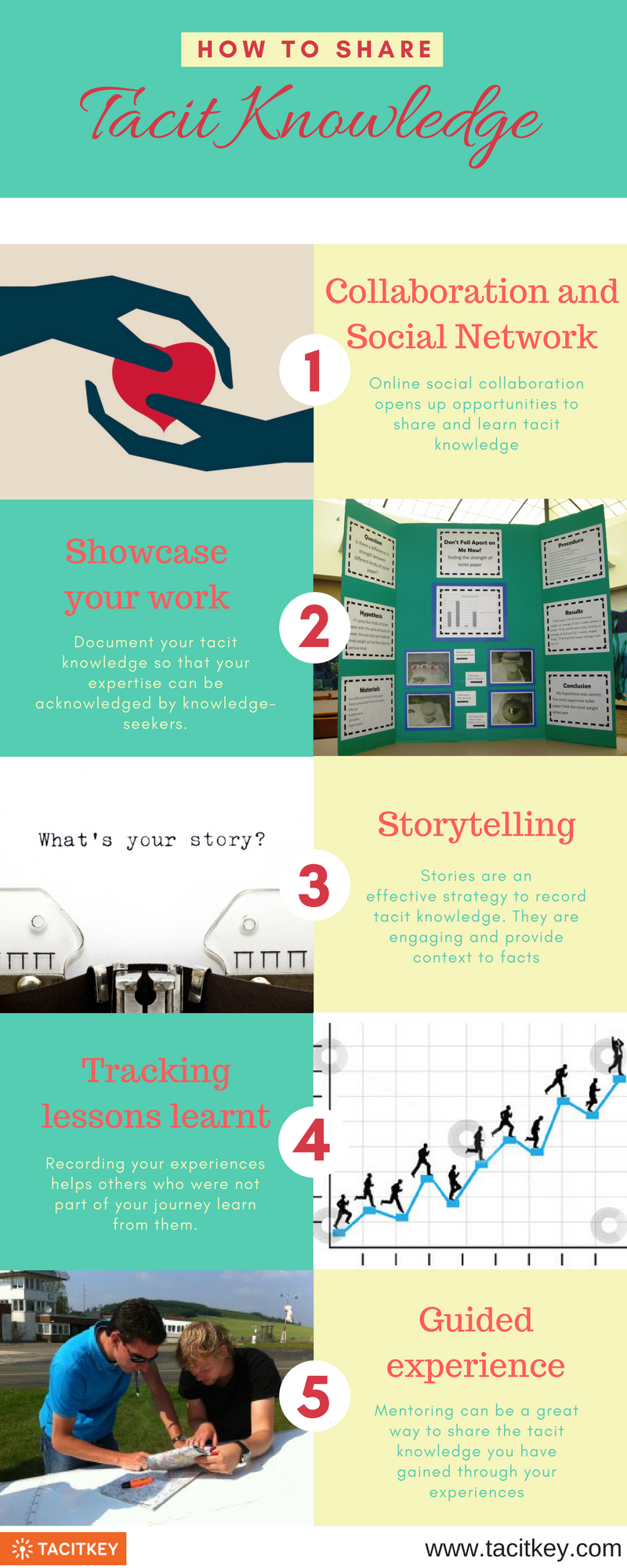- Invest in our thought leaders. Achieve your business goals. TacitKey For Business

5 Benefits Of Tacit Knowledge Sharing For Professionals.
September 22, 2017
Are you a Thought Leader? Relevance of Thought Leadership in your Domain
December 21, 2017Codifying Knowledge: How do you define “knowledge”?
“Knowledge” is a unique blend of contextual information, values, and insights. It forms the framework upon which you can build new experiences. It can be tacit knowledge or explicit knowledge.
Tacit Knowledge vs Explicit Knowledge
The interplay between tacit and explicit knowledge is required to create new knowledge. Tacit knowledge is based on personal experiences and is uncodified. As Polanyi said,
“We know more than we can tell.”
It is essentially created as a result of the interactions between people and their surroundings.
On the other hand, explicit knowledge is the knowledge that can be easily codified and is readily available in the form of books, documents etc. Hence, most of our learning focus on explicit knowledge and disregards tacit knowledge. However, this is a colossal mistake!
The relevance of Tacit Knowledge
An organization’s most valued asset is their in-house practices and knowledge. Charles Jennings, the former Chief Learning Officer of Reuters is the proponent of the 70:20:10 model. According to this model, 10% of the knowledge comes from formal training, 20% from informal training and 70% from on-the-job experience.
It is a combination of the 20% from social learning and 70% from hands-on learning that contributes to your tacit knowledge!
Few typical examples of organizational tacit knowledge include:
- Best practices adopted by your team
- Practical shortcuts utilized in your organization
- The intuition of a skilled individual
Tacit knowledge in an organization has been shown to improve:
- Productivity
- Decision-making capabilities
- Task performance
When employees leave an organization, they take a large amount of their tacit knowledge with them. Due to its non-codifiable nature, tacit knowledge cannot be efficiently transferred into manuals. This represents an irreplaceable loss for the organization. Over time, this results in a drastic loss in productivity across various departments.
Tacit Knowledge Transfer
Every month in the United States of America, approximately five million people leave their jobs. As a result, companies are rushing to find ways to capture and replace the lost tacit knowledge. Its personal and non-codifiable nature has definitely been a bump in the road in this journey, so far!
Methods of Tacit Knowledge Transfer

-
Social Interaction
According to a study, “Challenges in Managing Tacit Knowledge”, published in 2012, the most efficient way to share tacit knowledge is through social interaction. Zhu et al. (2016) also found that online social networks and collaborative platforms were extremely useful in the dissemination of tacit knowledge.
Online collaborations provide the frameworks for tacit knowledge transfer through “socially constructed learning”. However, for this to be effective, there must be a milieu of trust and openness.
-
Showcase your work
Showcasing your work makes it visible, along with the tacit knowledge involved in getting the work done. There are different ways of showcasing your work, such as:
(a) Working out loud
(b) Recording your work
When others go through your showcased work, they should be able to recognize, appreciate and grasp the knowledge involved. It is important to make ‘recording your work’ compulsory in any organization, to keep track of all the tacit knowledge involved.
-
Storytelling
Organizational stories are one of the most effective tools for capturing and transmitting tacit knowledge.
Stories provide the context to the information being conveyed. Thus, it helps people retain the knowledge for longer periods of time.
As proposed by Reamy, you can obtain tacit knowledge from employees who are leaving your organization in the form of stories, using structured interviews. Save these stories as part of the organizational knowledge, utilizing proper knowledge management systems.
-
Lessons learned
It is important to officially keep a track of lessons learned at the end of each event or meeting. This helps people who did not participate to benefit from the experience and gain knowledge, as well. This record keeping can be compared to a realistic case study, and as such, is a more effective method of knowledge sharing.
-
Guided Experience
As put forth by Leonard, Barton, and Barton, guided experience involves a mentoring approach called OPPTY. It stands for Observation, Practice, Partnering, Joint problem solving and Taking responsibility.
Observation Phase
In this phase, the mentee shadows the expert and learns by observing his approach and actions.
Practice Phase
In this phase, the mentee tries to replicate the expert’s behavior, with some help from the mentor.
Partnering Phase
In this phase, the mentor and mentee work together to analyze and address the issues faced by the mentee in the practice phase.
Taking Responsibility Phase
In this phase, the mentee takes over the expert’s role and takes responsibility for his actions. He gets the opportunity to think about all the steps involved in the experience and internalize the knowledge he has gained.
How Can TacitKey Help You?
TacitKey is an online knowledge sharing and monetization platform. Through our platform, you can collate your employees’ tacit knowledge and utilize it to improve your product and/ or train your employees. This increases the efficiency of the organization manifold.
Our platform acts as a tool to codify tacit knowledge. It converts inherent knowledge into recorded (explicit) knowledge. This recorded knowledge can be accessed and utilized by you at a later date or by other knowledge-seekers from all over the world.
The data in our platform is highly secure and permits you to store confidential organizational data for long periods of time.
Benefits of Using TacitKey
- Share your expertise or tacit knowledge with a global audience.
- Our proprietary algorithm ensures that your content is shared with people who are interested in similar topics. This increases the likelihood of fostering collaborations and sharing of ideas.
- Forming collaborations and partnerships increase your credibility. They help you become recognized as one of the prominent thought leaders in your domain.
- Showcase your expertise on our platform to create your personal brand. This will enhance your professional profile on the global stage.
- Engage with your peers and experts in your domain on a global stage. You can also collect professional inputs from them to take your career to the next level.
- Use your tacit knowledge to help improve products/marketing strategies and significantly increase your earning potential





